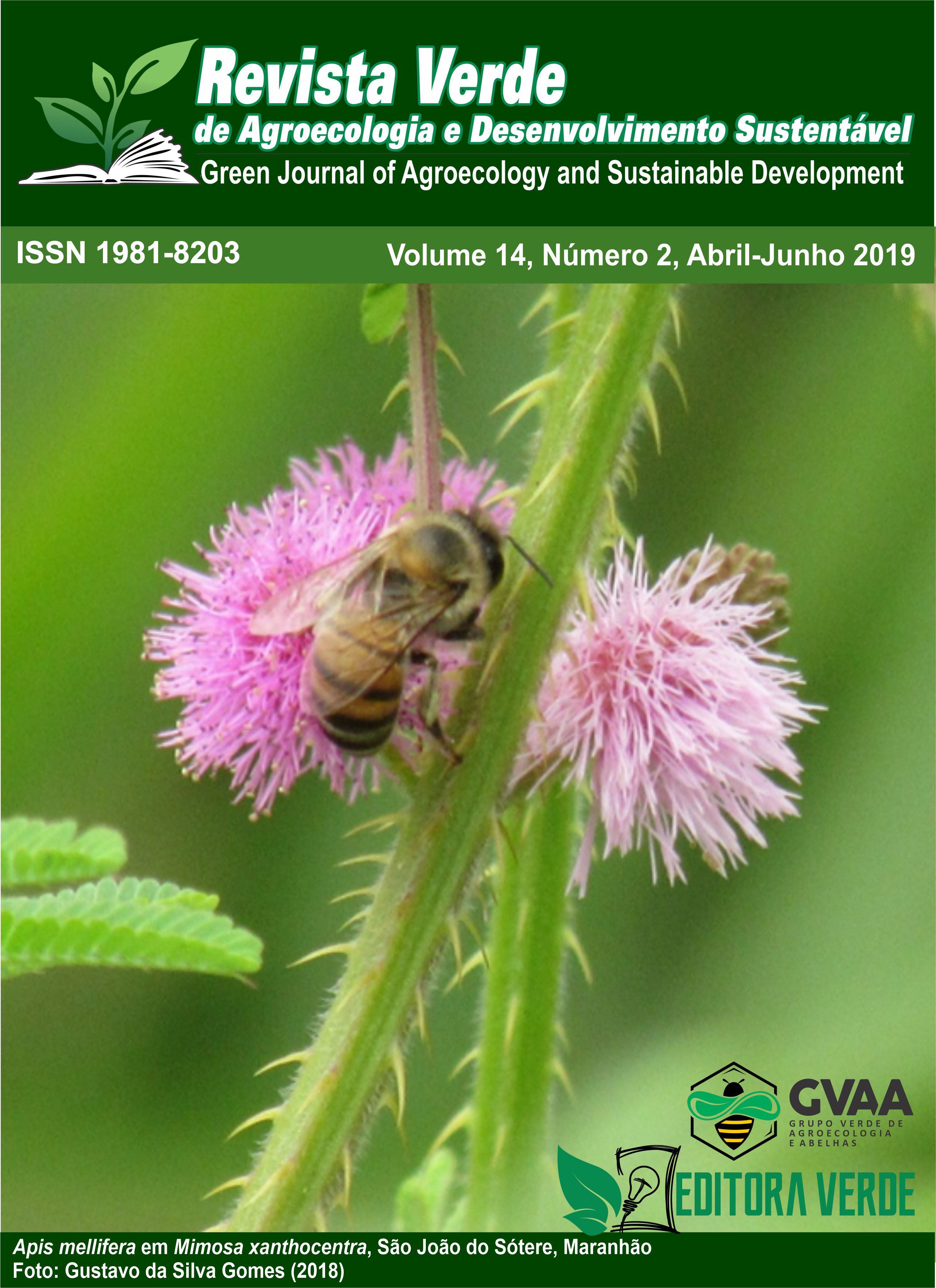Gray water footprint in cultivation of tomato in Brazilian semi-arid
DOI:
https://doi.org/10.18378/rvads.v14i2.6189Keywords:
Solanum lycopersicum, Agrochemicals, AgricultureAbstract
The gray water footprint (GWF) is defined as the volume of fresh water needed to dilute contaminants incorporated into the surface and subsurface layers of the soil, through the emission of agrochemicals in agricultural production. Therefore, the objective of this research was to evaluate the gray water footprint in tomato cultivation in Brazilian semiarid regions. The study was developed in the municipalities of Parelhas and Equador, both located in the state of Rio Grande do Norte. It was carried out a survey of the main pollutants, besides the environmental conditions of soil and climate, soon after the use of mathematical models to estimate the gray water footprint. The pesticides evaluated were Evidence, Lannate Br, Karate 50 EC, Sportak 450 EC, Sencor 480, Ridomil Gold and Confidor S. The insecticide Ridomil Gold (Chlorothalonil) was considered to be very offensive for tomato production in this study, its application should be avoided, and its replacement should be replaced by one that requires less fresh water for dilution. On the other hand, the pesticides Lannate BR (Methomyl), Karate 50 EC (Lambda-Cialotrina) and Sportak 450 EC (Procloraz) were the ones that presented less water requirement for dilution.Downloads
References
ARIAS-ESTEVEZ, M.; LOPEZ-PERIAGO, E.; MARTÍNEZ-CARBALLO, E.; SIMAL-GANDARA, J.; MEJUTO, J.; GARCIA-RI, O. L. The mobility and degradation of pesticides in soils and the pollution of groundwater resources. Agriculture, Ecosystems & Environment, v.123, n.4, p.247-260, 2008. https://doi.org/10.1016/j.agee.2007.07.011.
CARBO, L.; SOUZA, V.; DORES, E. F. G. C.; RIBEIRO, M. L. Determination of pesticides multiresidues in shallow groundwater in a cotton-growing region of Mato Grosso, Brazil. Journal of the Brazilian Chemical Society, v.19, n.6, p.1111-1117, 2008. http://dx.doi.org/10.1590/S0103-50532008000600009.
CMME, Canadian Council of Ministers of the Environment. Chemicals. 2018. Disponível em: <http://st-ts.ccme.ca/en/index.html>. Acesso em: 28 jun. 2018.
COSTA, P. S.; FERRAZ, R. L. S.; DANTAS NETO, J.; ANJOS, F. A.; CAVALCANTE JÚNIOR, C. A.; BARRETO, N. P.; MEDEIROS, A. S.; BARBOSA, M. A.; MAGALHÃES, I. D.; SANTOS, S. L. Virtual water consumption: a case study in a higher education institution in northeast Brazil. Journal of Scientific Research & Reports, v.18, n.1, p.1-12, 2018. http://dx.doi.org/10.9734/JSRR/2018/39250.
BRASIL. Ministério do Meio Ambiente. CONAMA 357/2005 - Dispõe sobre a classificação dos corpos de água e diretrizes ambientais para o seu enquadramento, bem como estabelece as condições e padrões de lançamento de efluentes, e dá outras providências. Diário Oficial da União –18/03/2005. 2005. Disponível em: <http://pnqa.ana.gov.br/Publicacao/RESOLUCAO_CONAMA_n_ 357.pdf>. Acesso em: 11 de nov. de 2018.
D’AGOSTINHO, A.; FLUES, M. Determinação do coeficiente de distribuição (Kd) de benzo(a)pireno em solo por isotermas de sorção. Química Nova, v.29, n.4, p. 657-661, 2006. http://dx.doi.org/10.1590/S0100-40422006000400006.
EUR, Europe Union Law. Directiva 2008/105/ce do parlamento europeu e do conselho. 2008. Disponível em: <https://eur-lex.europa.eu/legal-content/PT/TXT/?uri=CELEX:32008L0105>. Acesso em: 25 jun. 2018.
FRANKE, N. A.; BOYACIOGLU, H.; HOEKSTRA, A. Y. Grey Water Footprint Assessment: Tier 1 – Supporting Guidelines, Water Footprint Network, Enschede, The Netherlands. UNESCO-IHE, Institute for WaterEducation .Delft. 2013.
FROEHNER, S.; MARTINS, R. F. Avaliação do destino e bioacumulação de benzo(a)pireno através de simulação computacional. Química Nova, v. 31, n. 5, p. 1089-1093, 2008. http://dx.doi.org/10.1590/S0100-40422008000500028.
HOEKSTRA, A. Y.; MEKONNEN, M. M.; CHAPAGAIN, A. K.; MATHEWS, R. E.; RICHTER, B. D. Global monthly water scarcity: blue water footprints versus blue water availability. PlosOne, v. 7, n. 2, p. 1-32, 2012. https://doi.org/10.1371/journal.pone.0032688.
IBGE, Instituto Brasileiro de Geografia e Estatística. Censo Agropecuário. 2017. Disponível em: <https://cidades.ibge.gov.br/brasil/rn/>. Acesso em: 13 de nov. de 2018.
LIMA, W. T.; OLIVEIRA, A. M. L.; SILVA, I. O.; TANANTA, C. T.; COSTA, H. Uma geopolítica para as águas continentais na Amazônia Ocidental. Revista de Geopolítica, v. 9, n. 1, p. 11-21, 2018.
LOVARELLI, D.; BACENETTI, J.; FIALA, M. Water Footprint of crop productions: A review. Science of the Total Environment, v. 548-549, n. 1, p. 236-251, 2016. https://doi.org/10.1016/j.scitotenv.2016.01.022.
MATOS, R. M.; BORGES, V. E.; LIMA, A. S.; SILVA, P. F.; NETO, J. D.; LIMA, V. L. A. Sustainability of the grey water footprint (GWF) for cultivation of onion in the Brazilian semi-arid regions. Australian Journal of Crop Science, v. 11, n. 6, p. 749-756, 2017. https://doi.org/10.21475/ajcs.17.11.06.p569
PAGE, G.; RIDOUTT, B.; BELLOTTI, B. Carbon and water footprint tradeoffs in fresh tomato production. Journal of Cleaner Production, v, 32, n. 1, p. 219-226, 2012. https://doi.org/10.1016/j.jclepro.2012.03.036.
PALHARES, J. C. P. Pegada hídrica de suínos e o impacto de estratégias nutricionais. Revista Brasileira de Engenharia Agrícola e Ambiental, v. 18, n. 5, p. 533-538, 2014. http://dx.doi.org/10.1590/S1415-43662014000500010.
PINA, L. A. B. Pegada Hídrica associada à produção do vinho verde branco. 2010. 92f. Dissertação (Mestrado) - Departamento de Ambiente e Ordenamento. Universidade de Aveiro, Portugal. 2010.
RAMÍREZ, T.; MEAS, Y.; DANNEHL, D.; SCHUCH, I.; MIRANDA, L.; ROCKSCH, T.; SCHMIDT, U. Water and carbon footprint improvement for dried tomato value chain. Journal of Cleaner Production, v. 104, n. 1, p. 98-108, 2015. https://doi.org/10.1016/j.jclepro.2015.05.007.
RIVAS IBÁÑEZA, G.; MOLINA RUÍZ, B. J. M.; ROMÁN SÁNCHEZ, M. I.; CASAS LÓPEZA, J. L. A corporate water footprint case study: The production of Gazpacho, a chilled vegetable soup. Water Resource and Industry, v.17, n. 1, p. 34-42, 2017. https://doi.org/10.1016/j.wri.2017.04.001.
SANTIAGO, A. D.; CHICO, D.; ANDRADE JUNIOR, A. S.; GARRIDO, A.; CARNAÚBA, P. J. P. Pegada hídrica da cana-de-açúcar e etanol produzidos no estado de Alagoas, Brasil. Agrometeoros, v. 25, n. 1, p. 209-216, 2017.
SILVA, T.; MOREIRA, A. Agrotóxicos: Um estudo acerca dos conhecimentos de agricultores sobre o uso dos agrotóxicos utilizados nos municípios de Parelhas-RN e Equador-RN para o cultivo do tomate. In: 52° Congresso Brasileiro de Química. Recife-PE. 2012. Disponível em: <http://www.abq.org.br/cbq/2012/trabalhos/5/801-10817.html>. Acesso em: 20 jun. 2018.
US-EPA, United States Environmental Protection Agency. National Recommended Water Quality Criteria - Aquatic Life Criteria Table. 2018. Disponível em: <https://www.epa.gov/wqc/national-recommended-water-quality-criteria-aquatic-life-criteria-table#main-content>. Acesso em: 28 jun. 2018.











